Road-trip in Gaspesie
QUÉBEC > RIMOUSKI > BONAVENTURE > PÉRCÉ > GASPÉ > TADOUSSAC>LA MALBAIE
Itinerary
-
Day 1 Québec city
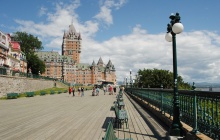 Welcome to Quebec City! This city is bursting with history, nature and culture. Quebec City will certainly be a favorite.
Welcome to Quebec City! This city is bursting with history, nature and culture. Quebec City will certainly be a favorite.
- Accommodation: Hotel
-
Day 2 Québec city
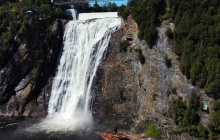 Take the opportunity to visit the icon of Quebec City: The Château Frontenac. Relive the history of this sublime castle which offers a breathtaking view.
Take the opportunity to visit the icon of Quebec City: The Château Frontenac. Relive the history of this sublime castle which offers a breathtaking view.
- Accommodation: Hotel
-
Day 3 Québec / Bic national park
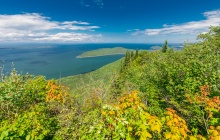 An adept of nature? The Bic national park will seduce you. It offers you an one-on-one experience with nature. Take the opportunity to take a walk in the forest, rent a kayak, or meet the famous black bear!
An adept of nature? The Bic national park will seduce you. It offers you an one-on-one experience with nature. Take the opportunity to take a walk in the forest, rent a kayak, or meet the famous black bear!
- Accommodation: Lodge
- Transportation: approx. 211 mi, approx. 3h30 -
Day 4 Bic national park
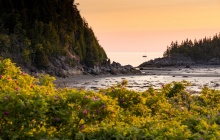 It is an experience that should not be missed by outdoor lovers, you will discover landscapes that will take your breath away. You will be totally immersed in the heart of Quebec nature.
It is an experience that should not be missed by outdoor lovers, you will discover landscapes that will take your breath away. You will be totally immersed in the heart of Quebec nature.
- Accommodation: Lodge
-
Day 5 Bic national park / Bonaventure
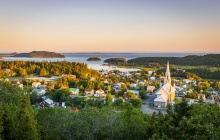 Then go discover the beauty of Bonaventure and Acadia. We give you the opportunity to experience a privileged moment in contact with some forty animal species, such as the famous white-tailed deer or beavers, along an open-air trail in the Bio-parc de la Gaspésie.
Then go discover the beauty of Bonaventure and Acadia. We give you the opportunity to experience a privileged moment in contact with some forty animal species, such as the famous white-tailed deer or beavers, along an open-air trail in the Bio-parc de la Gaspésie.
- Accommodation: Hotel
- Transportation: approx. 199 mi, approx. 4h -
Day 6 Bonaventure
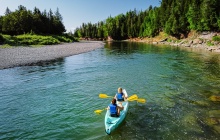 Take the chance to experience a unique moment in contact with some forty animal species, such as the famous white-tailed deer or beavers, along an open-air trail in the Bio-parc de la Gaspésie.
Take the chance to experience a unique moment in contact with some forty animal species, such as the famous white-tailed deer or beavers, along an open-air trail in the Bio-parc de la Gaspésie.
Suggested activity ($):
- Visit the Bioparc de la Gaspésie- Accomodation: Hotel
-
Day 7 Bonaventure / Percé
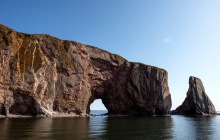 Heading to Percé, one of the most spectacular coastal landscapes in Quebec, which shelters the legendary Percé Rock and a colony of Northern Gannet.
Heading to Percé, one of the most spectacular coastal landscapes in Quebec, which shelters the legendary Percé Rock and a colony of Northern Gannet.
- Accommodation: Hotel
- Transportation: approx. 121 mi, approx. 2h30 -
Day 8 Percé
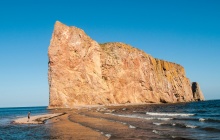 Head for Bonaventure Island and its 110,000 gannets! Stroll along the island's various trails to take full advantage of the scenery and this very special setting.
Head for Bonaventure Island and its 110,000 gannets! Stroll along the island's various trails to take full advantage of the scenery and this very special setting.
- Accommodation: Hotel
-
Day 9 Percé / Gaspé
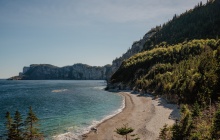 Take advantage of this second day to discover the amazing wonders the of Parc national de Forillon and stroll to the Cap Gaspé lighthouse.
Take advantage of this second day to discover the amazing wonders the of Parc national de Forillon and stroll to the Cap Gaspé lighthouse.
- Accommodation: Hotel
- Transportation: approx. 39 mi, approx. 1h -
Day 10 Gaspé / Gaspésie National Park
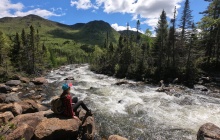 Head for Parc National de la Gaspésie, one of Quebec's top hiking destinations. In the heart of this exceptional mountain environment, you may be lucky enough to spot the last remaining herd of caribou in the region south of the St. Lawrence River.
Head for Parc National de la Gaspésie, one of Quebec's top hiking destinations. In the heart of this exceptional mountain environment, you may be lucky enough to spot the last remaining herd of caribou in the region south of the St. Lawrence River.
- Accommodation: Lodge
- Transportation: approx. 106 mi, approx. 2h15 -
Day 11 Gaspésie national park
 Continue exploring the exceptional Parc national de la Gaspésie! Hike to Lac aux Américains, a glacial cirque of exceptional scenery!
Continue exploring the exceptional Parc national de la Gaspésie! Hike to Lac aux Américains, a glacial cirque of exceptional scenery!
- Accommodation: Lodge
-
Day 12 Gaspésie National Park / Tadoussac
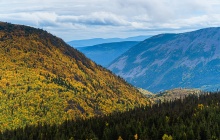 Let's go for a short cruise and a crossing of the great river, with an exceptional panoramic view.
Let's go for a short cruise and a crossing of the great river, with an exceptional panoramic view.
- Accommodation: Hotel
- Transportation: approx. 217 mi, approx. 5h15 -
Day 13 Tadoussac / Baie-Saint-Paul
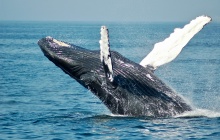 Get ready! We then suggest you to take off to meet the famous Whales of Tadoussac! Don't forget your camera. You will then follow the great river on one of the most beautiful roads in Quebec.
Get ready! We then suggest you to take off to meet the famous Whales of Tadoussac! Don't forget your camera. You will then follow the great river on one of the most beautiful roads in Quebec.
- Included activity : whale watching cruise
- Accommodation: Hotel
- Transportation: approx. 87 mi, approx. 2h15 -
Day 14 Baie-Saint-Paul
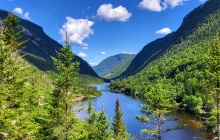 Baie-Saint-Paul is the perfect city to admire the panoramic landscapes of the river and mountains. One of the most beautiful sunsets in Quebec will be waiting for you. You will also be amazed by the splendid Charlevoix region.
Baie-Saint-Paul is the perfect city to admire the panoramic landscapes of the river and mountains. One of the most beautiful sunsets in Quebec will be waiting for you. You will also be amazed by the splendid Charlevoix region.
- Accommodation: Hotel
-
Day 15 Departure
It's time to leave. Enjoy the last moments in the city of Quebec as well as a last poutine before heading to the airport. Enjoy your meal!
- Transportation: approx. 81 mi, approx. 1h30
Period & budget
When to travel?
The best period for travelling is during the following months:
| Jan | Feb | Mar | Apr | May | Jun | Jul | Aug | Sep | Oct | Nov | Dec |
Price
The budget is an indication of the price per person, subject to availability. Your local agent will send you a customized quote with the exact price. The price can vary according to availability, level of services, period of travel, number of participants, booking time frame and other items.
Included
- 14 nights' standard accommodation
- 13-day rental of a mid-size Hyundai Elantra or equivalent, unlimited mileage, LDW and ALI insurance, local taxes, airport fees, one tank of gas and an additional driver
- The following activity: whale watching cruise by zodiac (2h)
- Roadbook (electronic version)
- Canadian taxes (federal and provincial)
- 24-hour assistance
Not included
- International flights (available on request)
- Gasoline
- Personal expenses
- Meals
- Beverages (except tea and coffee for included meals)
- Entrance fees to national parks
- Optional activities
- Travel insurance
International flights
Terms and conditions
Booking conditions
Invoice procedure
Cancellation policy
If cancellation occurs:
- More than 31 days before departure: 20% of the total booking amount (excluding insurance and fixed fees)
- Between 30 and 21 days before departure: 35% of the total booking amount (excluding insurance and fixed fees)
- Between 20 and 14 days before departure: 50% of the total booking amount (excluding insurance and fixed fees)
- Between 13 and 7 days before departure: 75% of the total booking amount (excluding insurance and fixed fees)
- Less than 7 days before departure: 100% of the total booking amount (excluding insurance and fixed fees)
Regardless of the cancellation or contract modification date, the following fees are added to the standard cancellation terms above:
- Airfare fees: If your flight ticket has to be issued well in advance—often to secure the best fare—100% of the non-refundable flight costs will be charged in case of cancellation or change. In this case, the standard cancellation terms apply only to the land portion of the trip.
- Land service fees: Any non-refundable fees incurred early for firm bookings will be charged in case of cancellation.
- Insurance: Whether you purchased multi-risk or cancellation insurance, the insurance premium is non-refundable under any circumstances.
The date the written notice is received will be considered the official cancellation date and will determine the applicable cancellation fees.
Altaï Canada may also cancel a trip due to exceptional circumstances considered force majeure (e.g., volcanic eruptions, social unrest, strikes, severe weather) that could compromise the safety of participants. In such cases, all amounts paid will be fully refunded, but no additional compensation can be claimed.
Changes to travel contract
Pricing
Contract transfer
Insurance
Practical info
Staff
- A day by day (itinerary) description
- Destination description
- Useful tips on driving
- Cities and parks maps
- Activities description
Food
Accommodation
Transportation
Budget & exchange
Tips
Supplied equipment
Luggage
Passport
Health information & recommendations
Weather
Electricity
Local time
Topography
Sustainable tourism
- A fair economical repartition
- The improvement of local teams’ working conditions and their awareness of the protection of the environment
- The information of travelers about respecting the local population and environment and the collection of their feelings at their return.
- Avoid letting waste out, throw it in the trash can or bring it with you
- Use potable water sparingly (take a shower instead of a bath and report any leaks) and avoid wasting it (use biodegradable soap to wash yourself)
- Avoid damaging cultural sites: don’t touch the statues, don’t move the stones and objects
- Exchange instead of giving (too Important gifts can destabilize the local economic stability of the country depending on their living standards)
- When taking a walk, especially in some fragile ecosystems, observe the fauna from afar, do not go beyond beaten roads, limit stamping and do not bring any souvenirs: give up picking rare flowers picking fossils...
- In some hotels, you can have individual air conditioning. It is advised to systematically switching it off when you’re out of the room to avoid energetical overconsumption and greenhouse gas emission.


